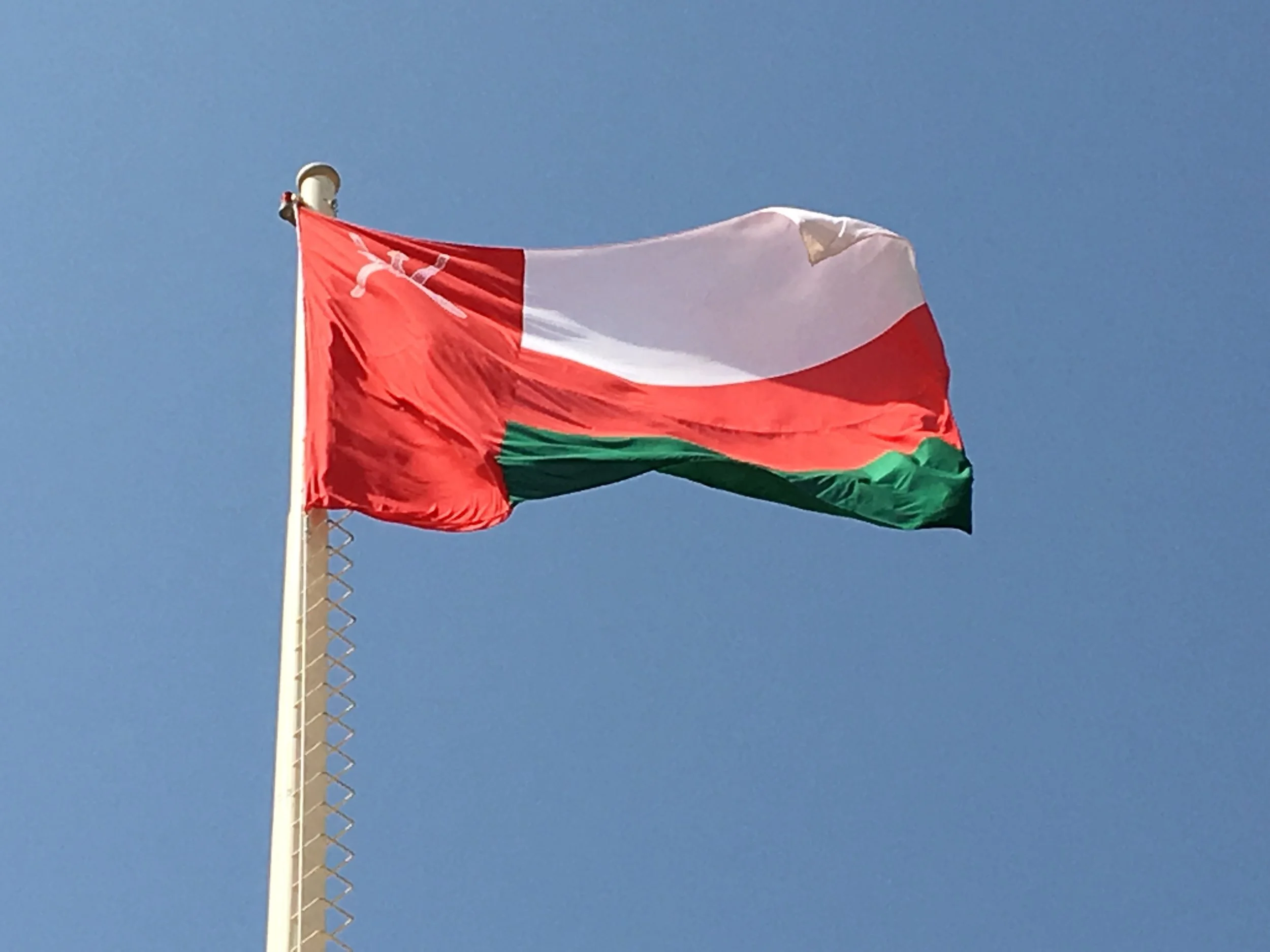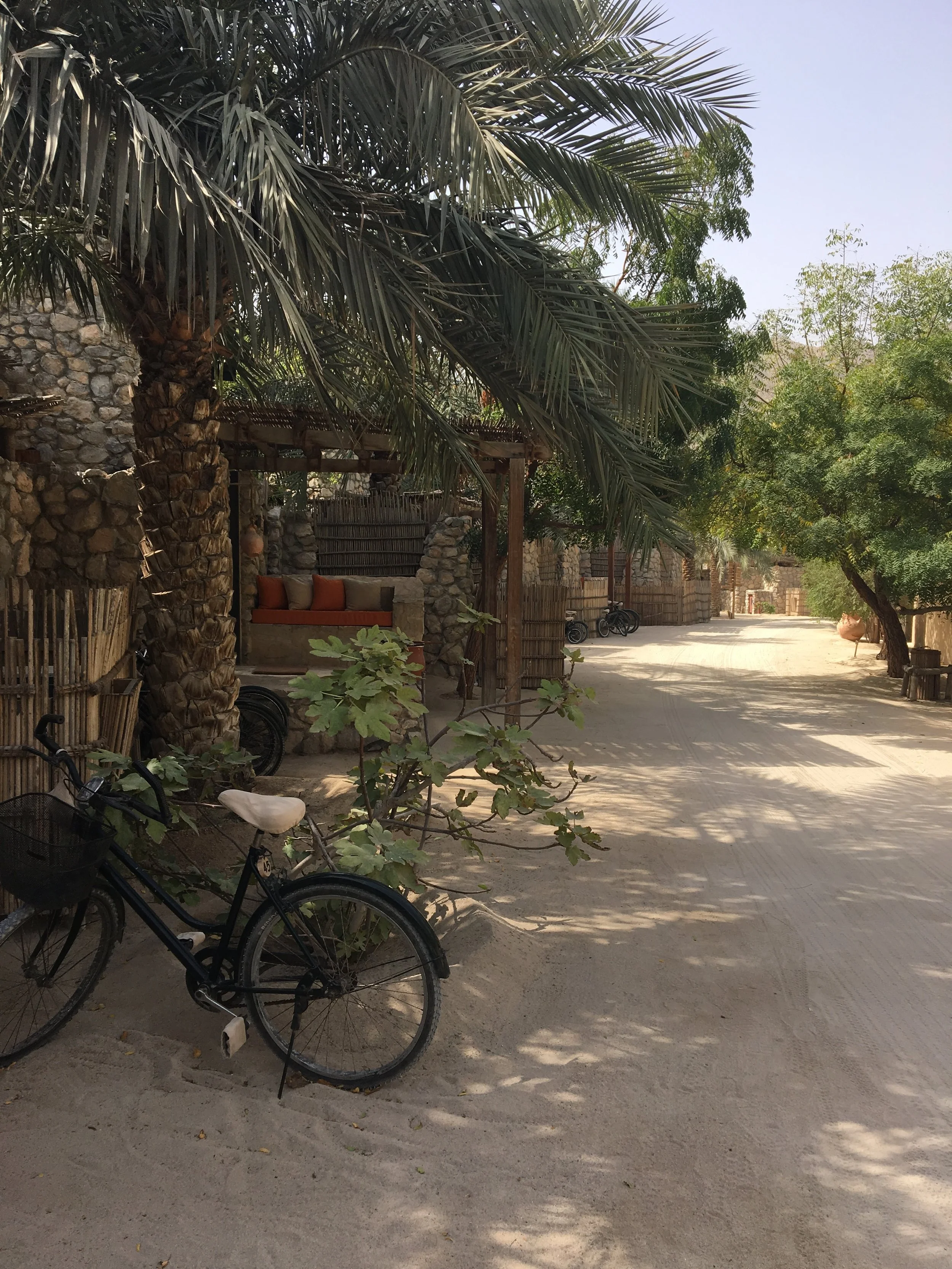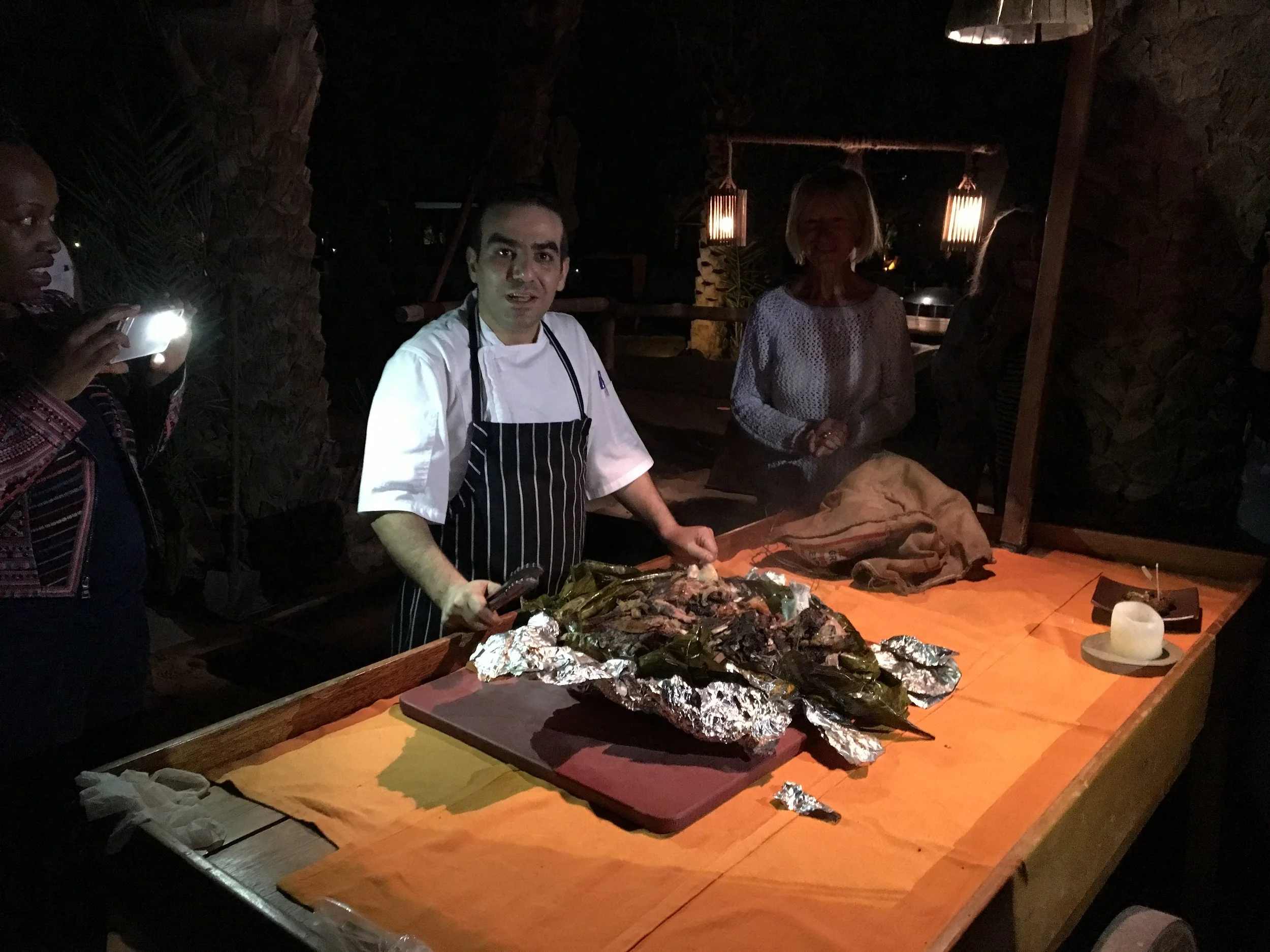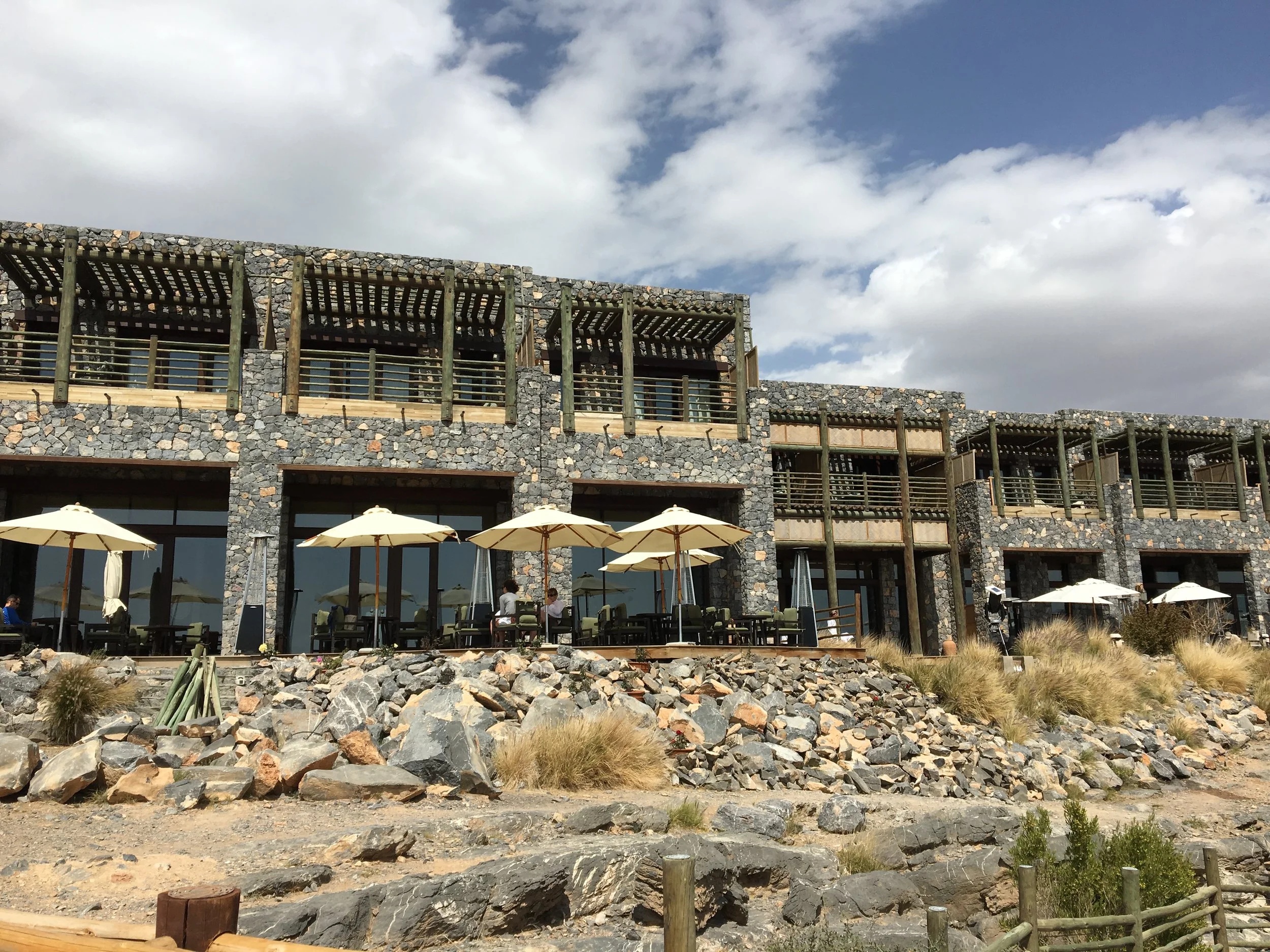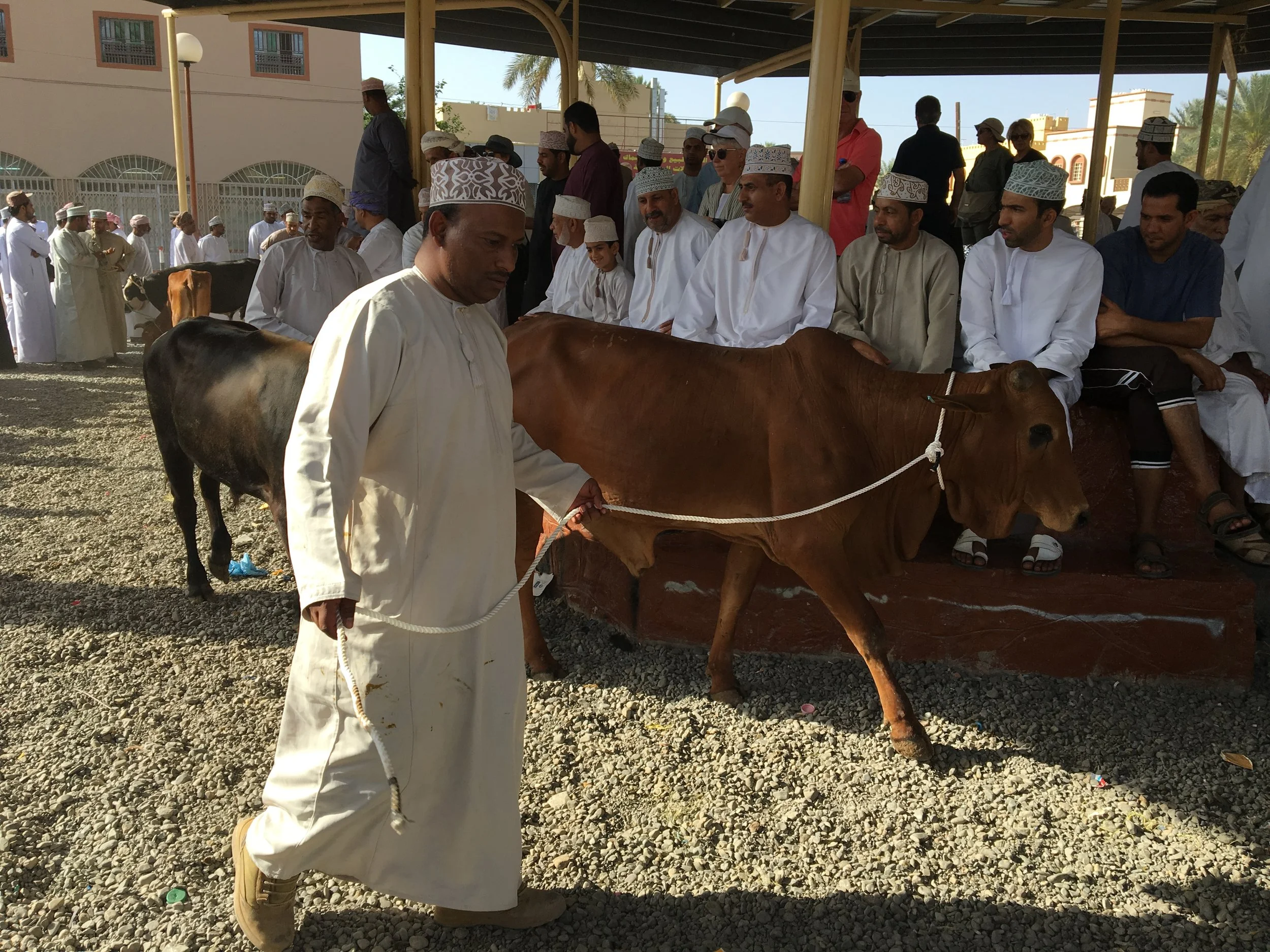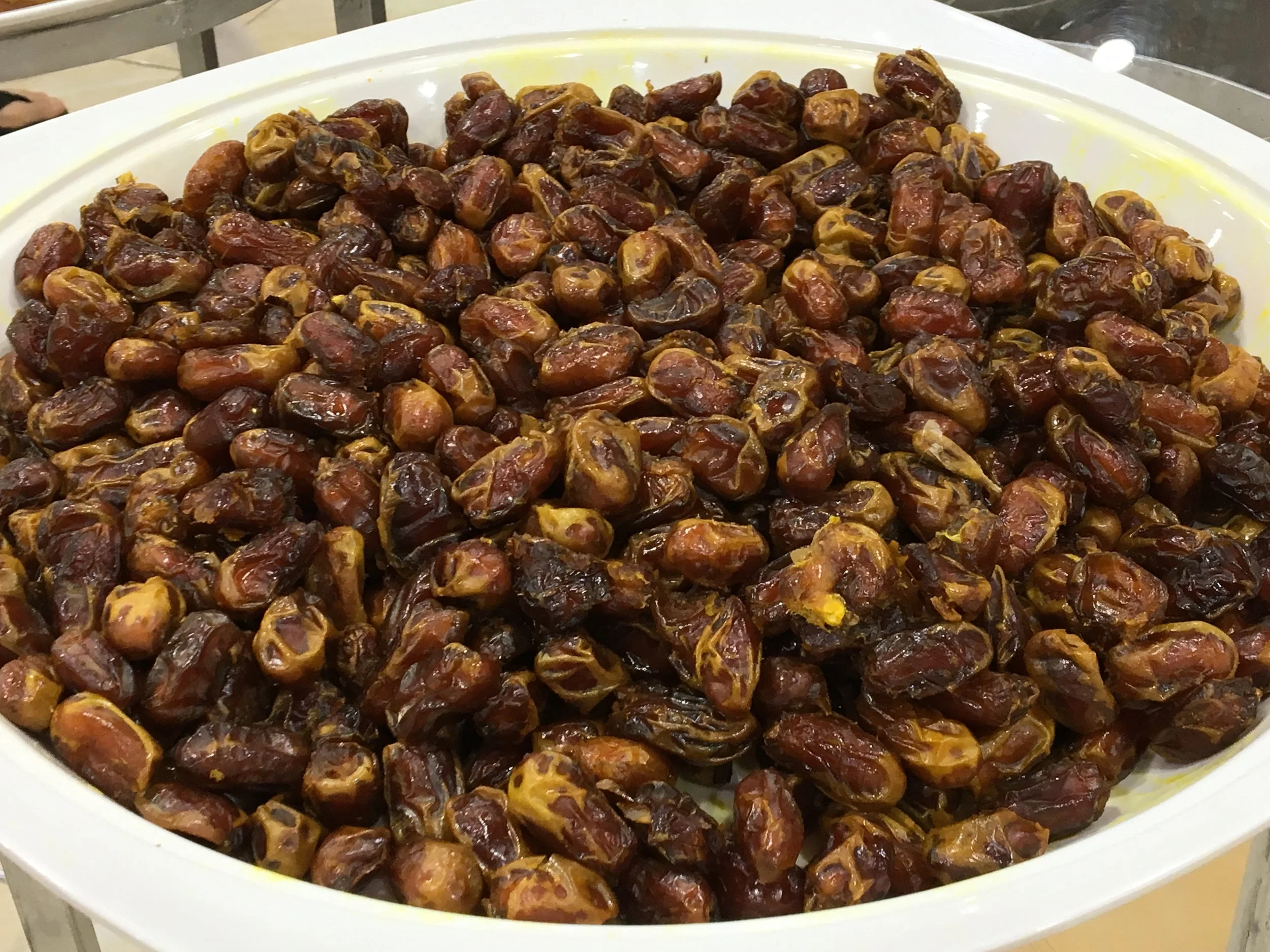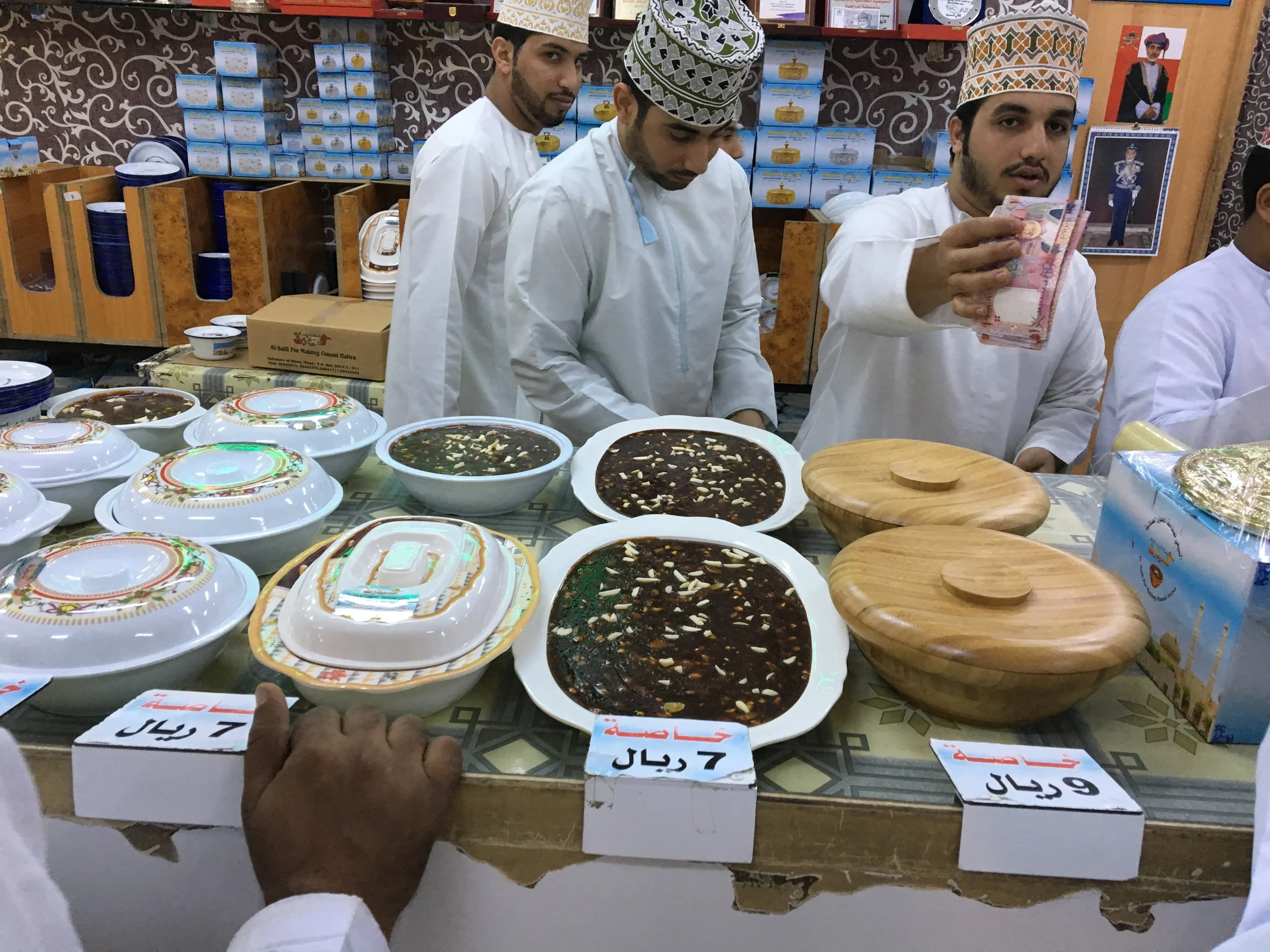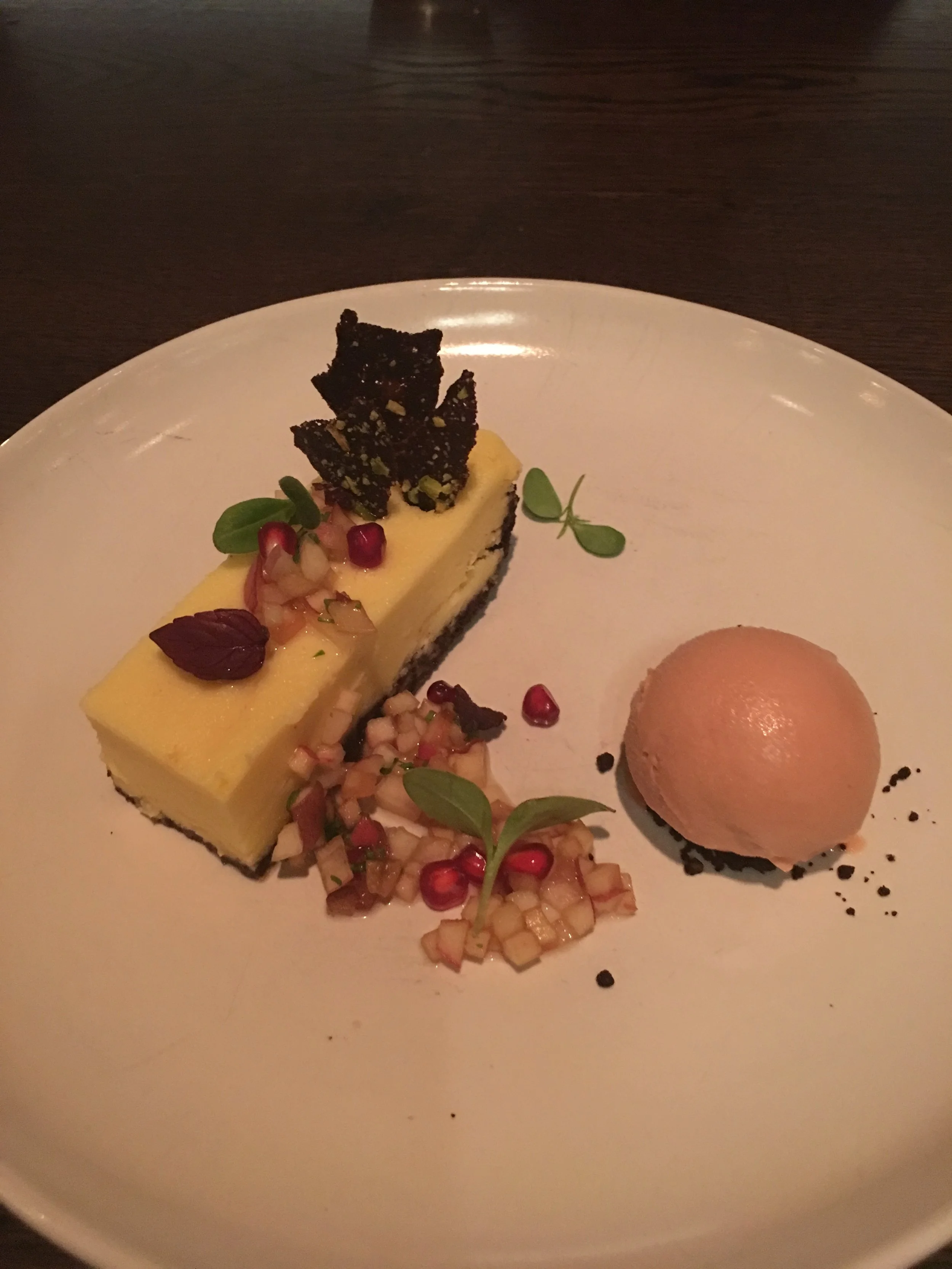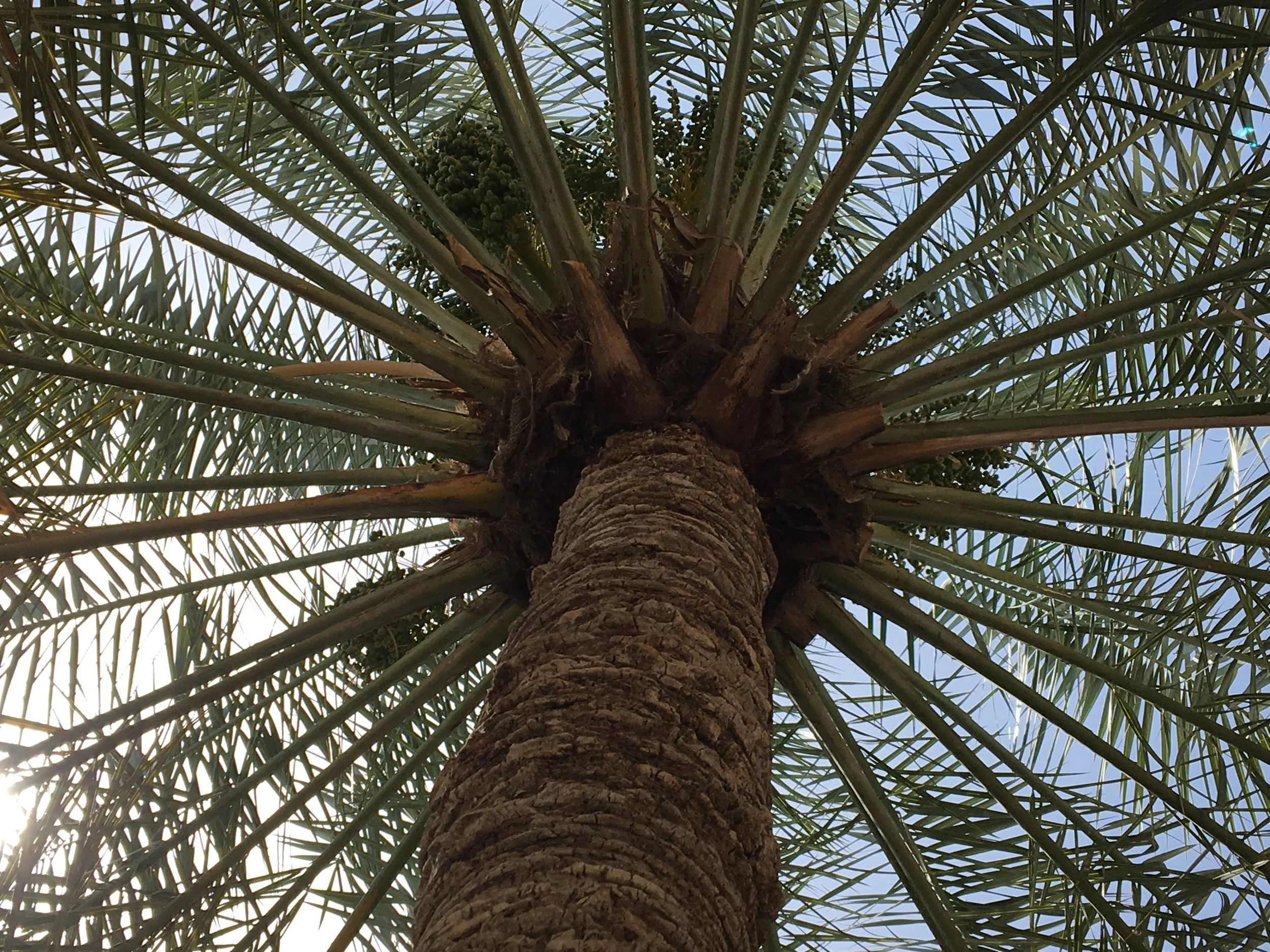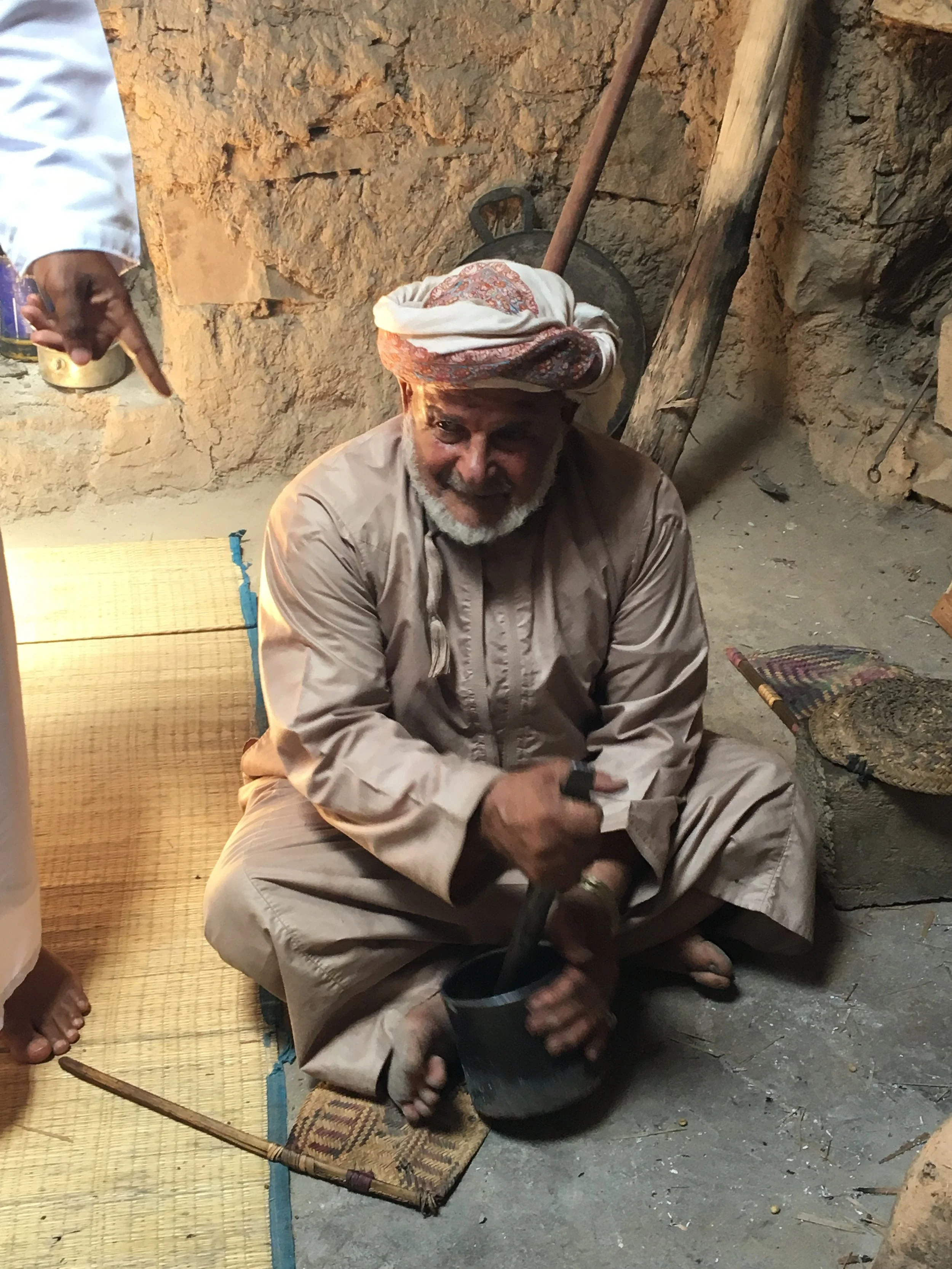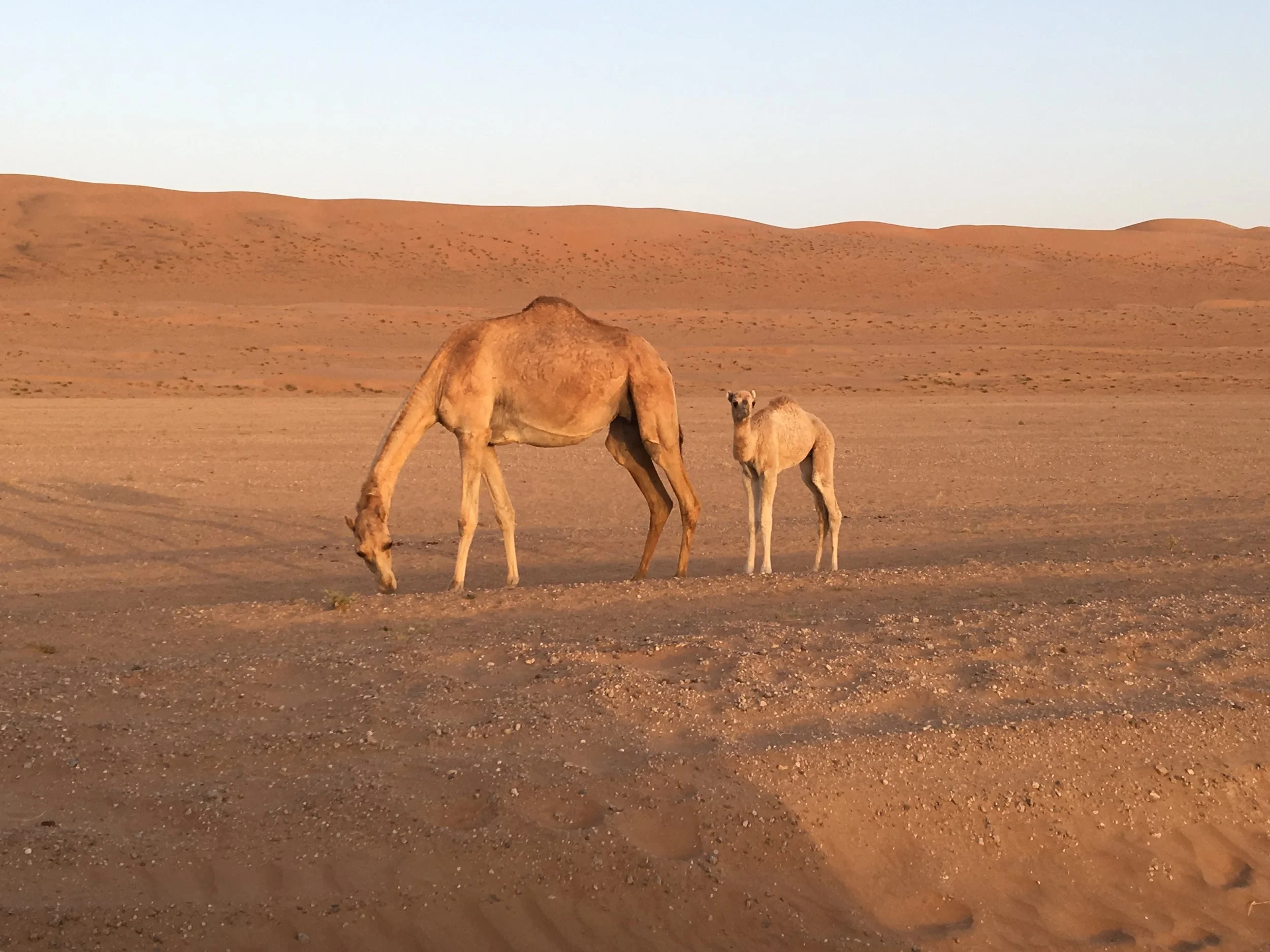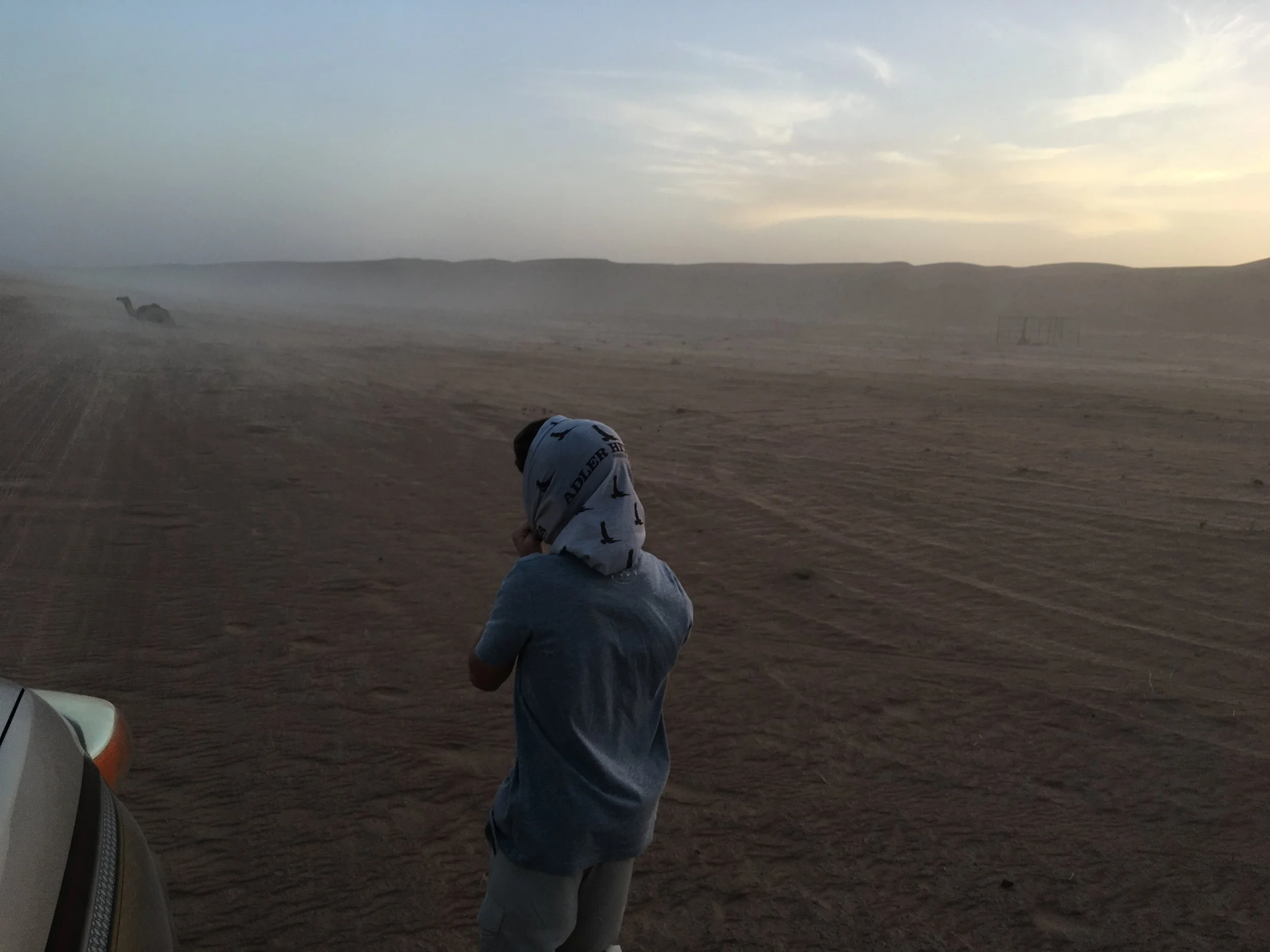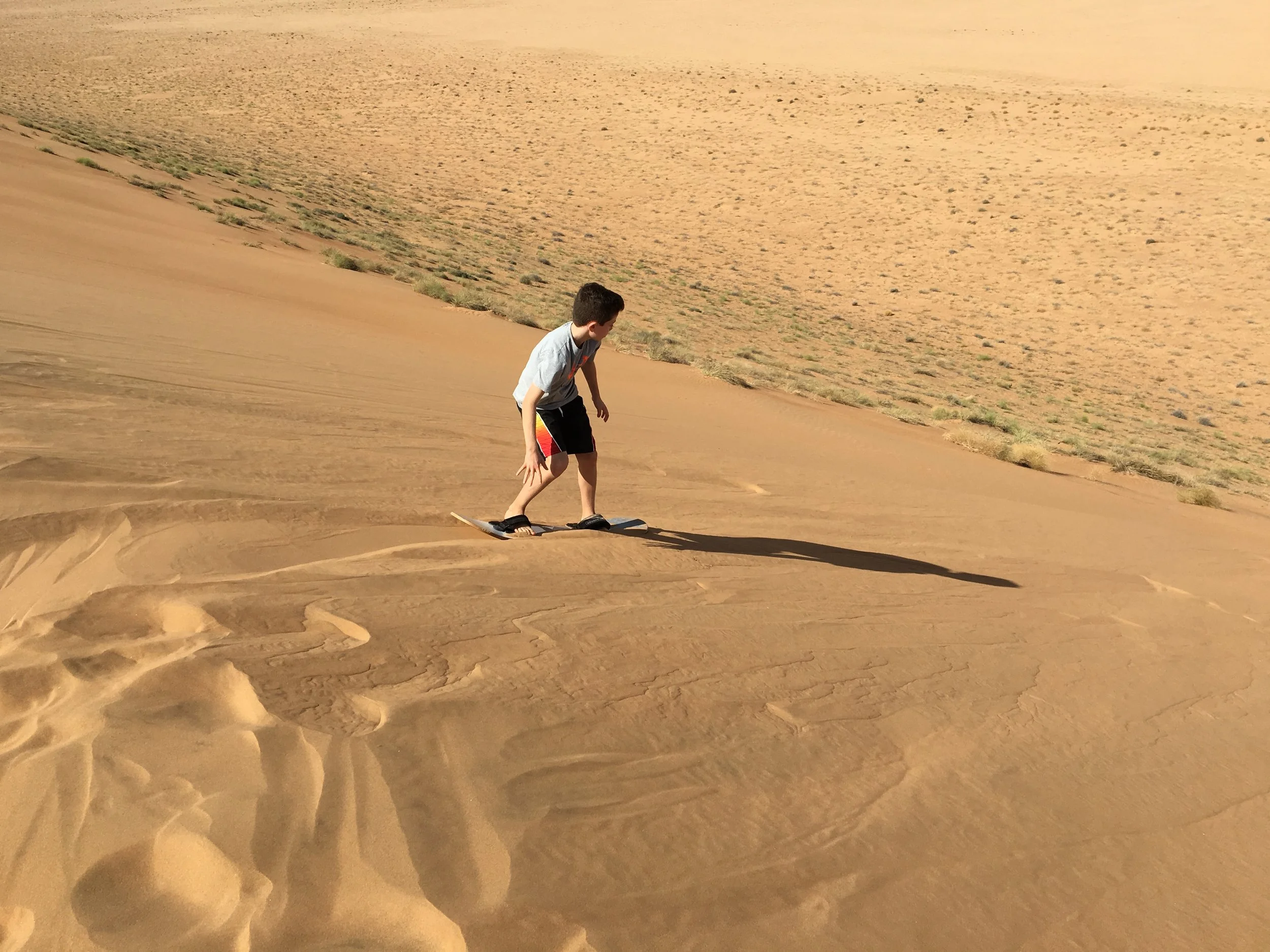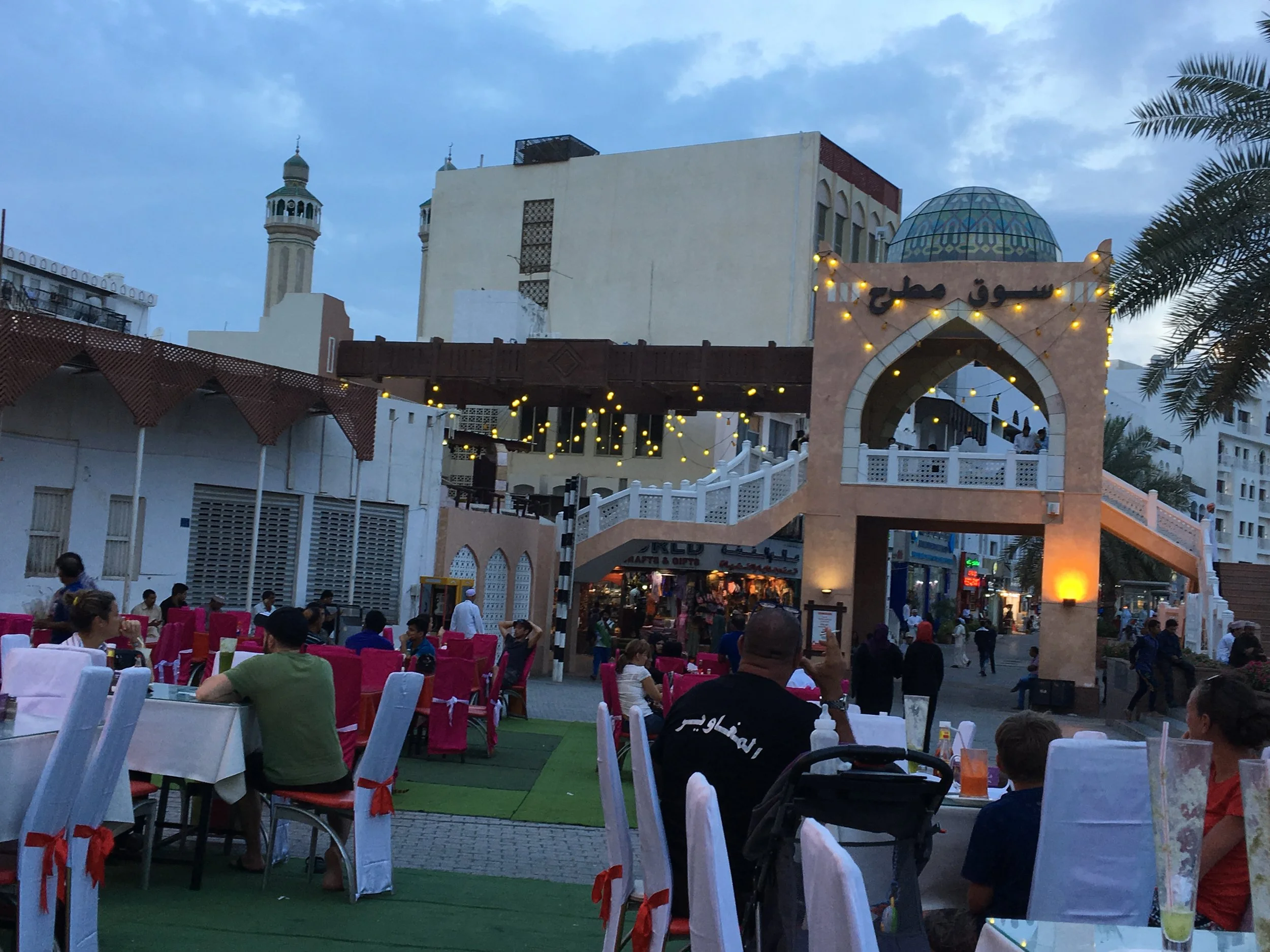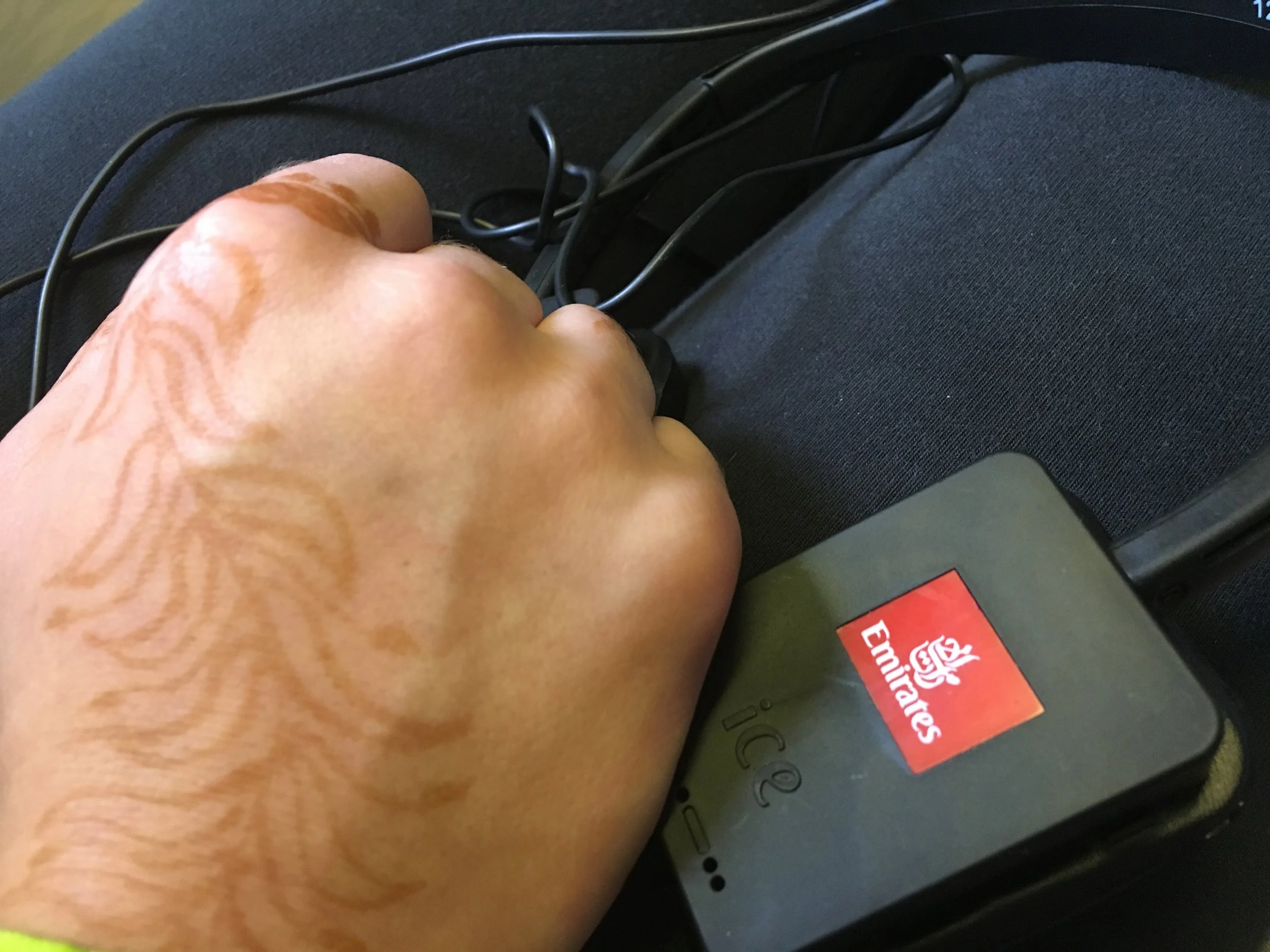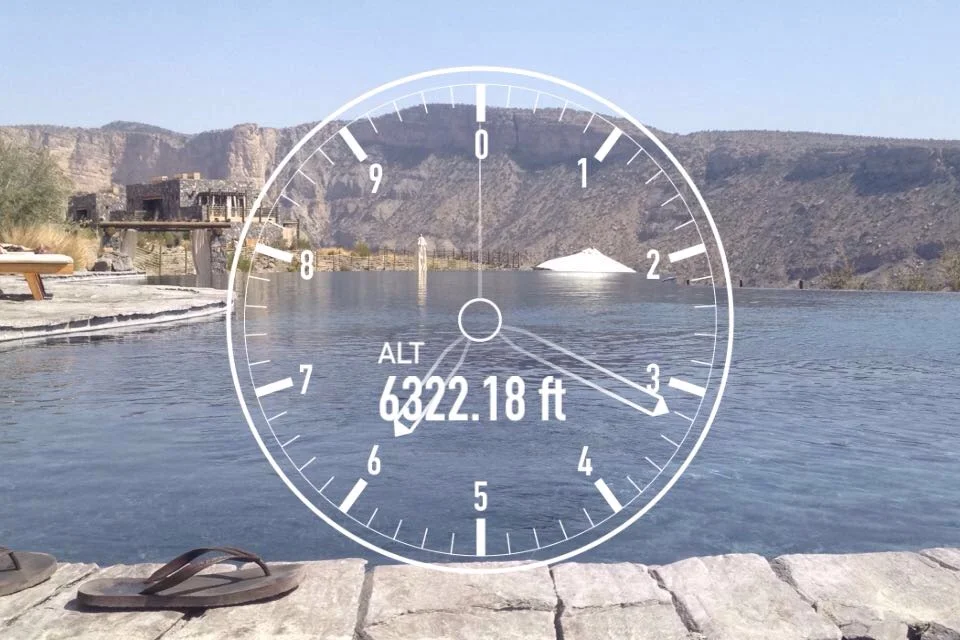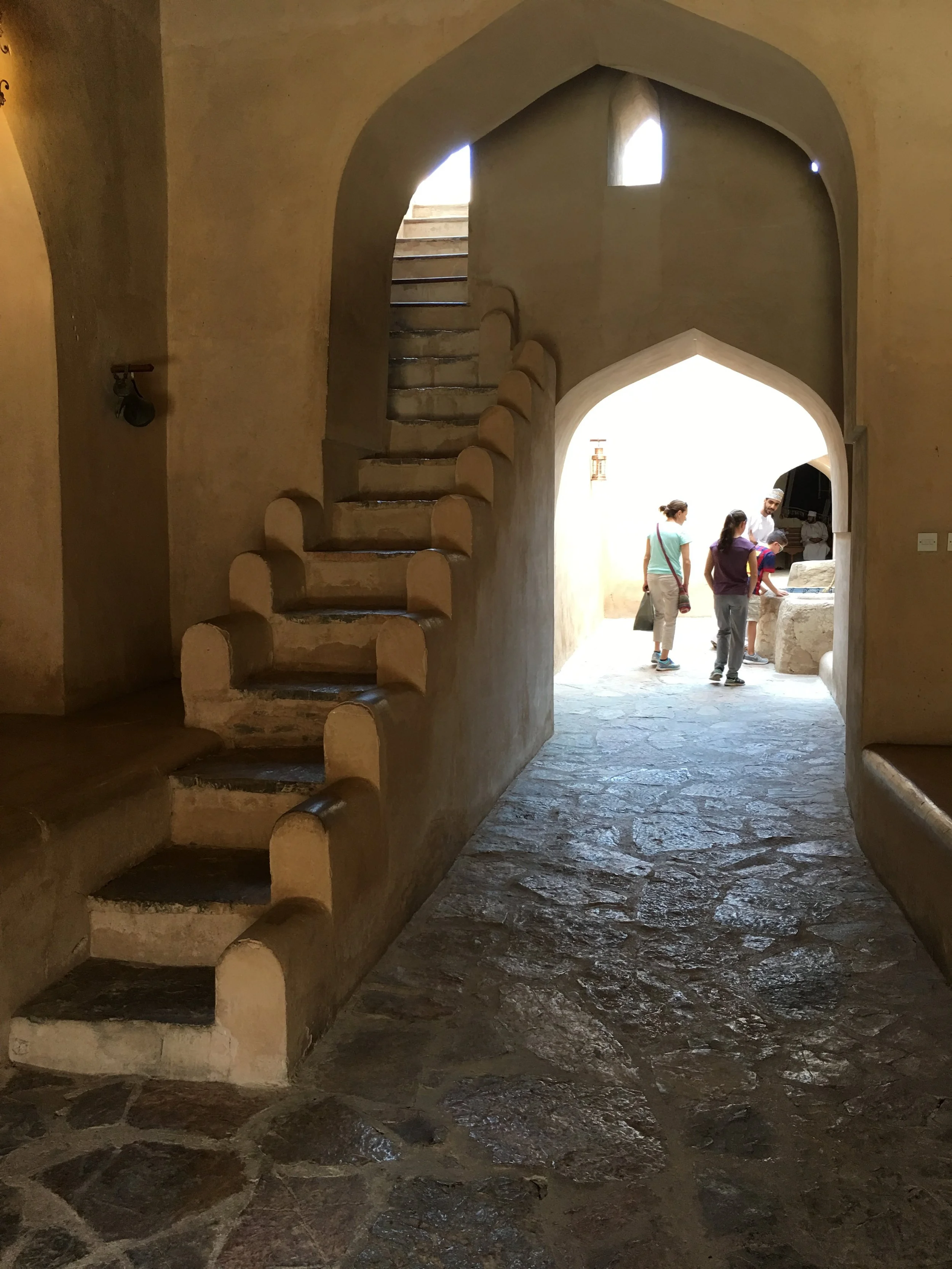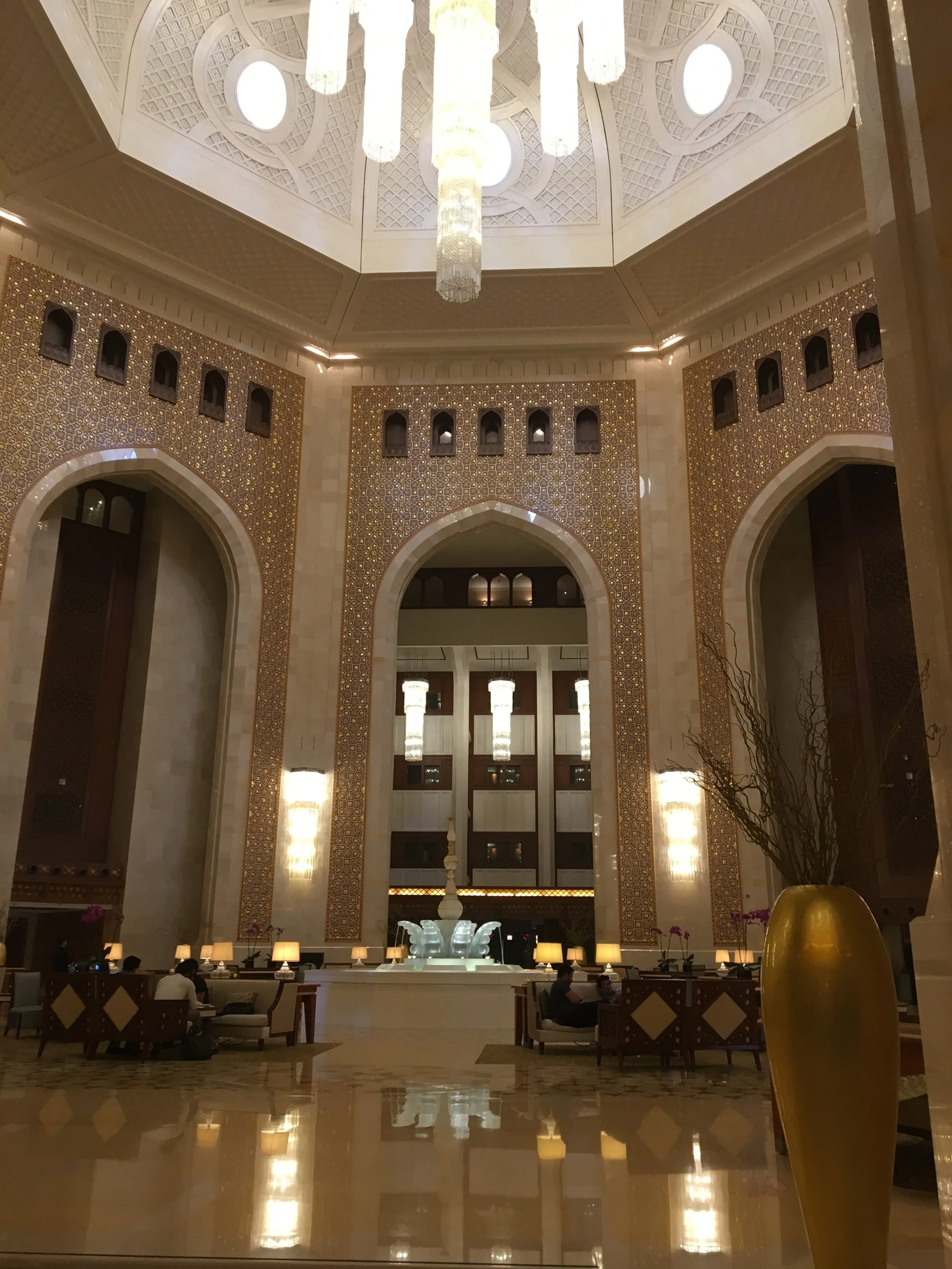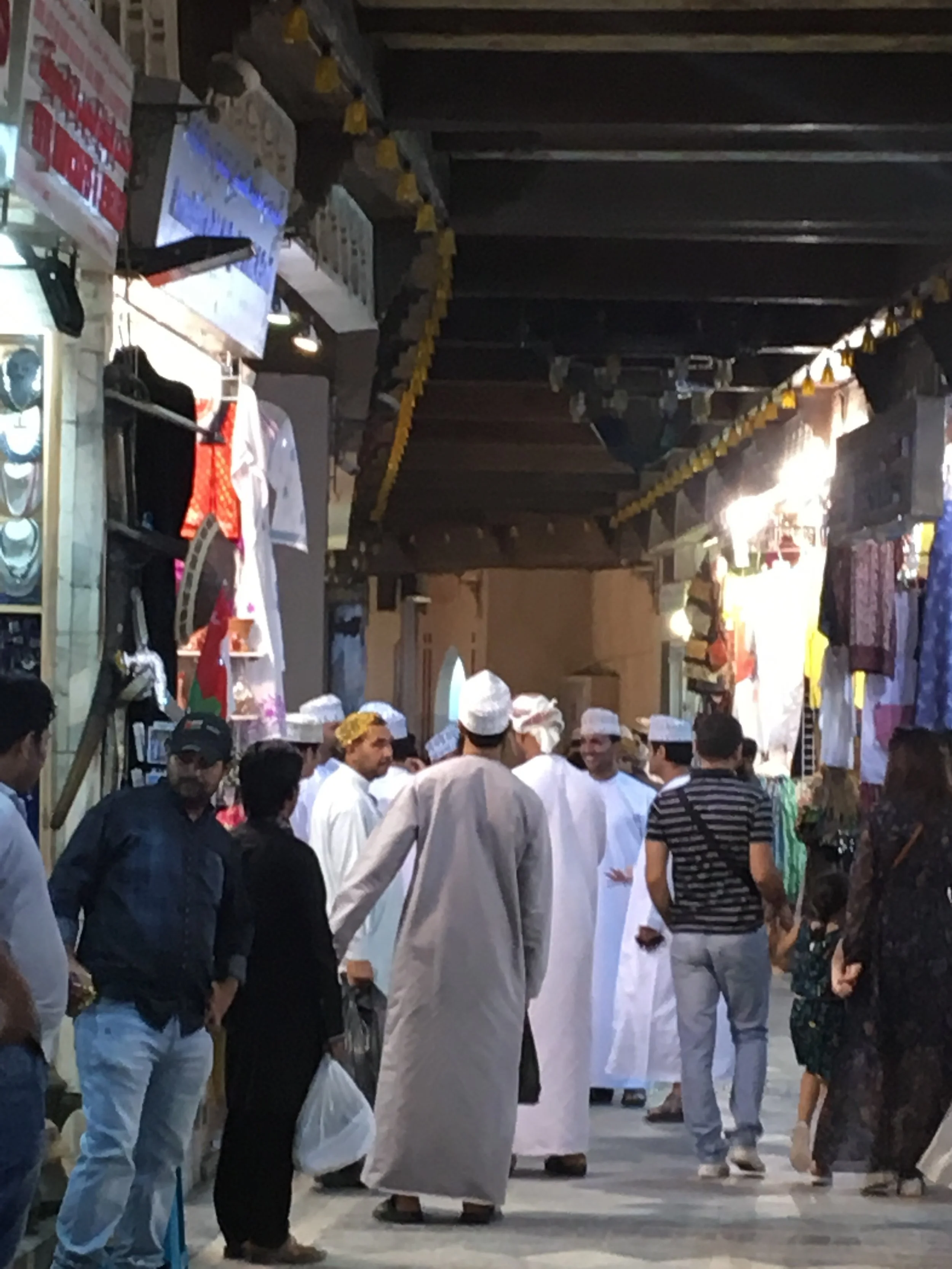Oman
Written by Jennifer Milano, March 2017
The Wahiba Sands Desert, Oman
Lots of people asked where we were going for spring break this March. When I replied, "Oman," I was met with a quizzical look. After a handful of these reactions, I edited my answer to a hesitant: "Oman, on the Arabian Peninsula?" Most people asked where Oman was. Everyone asked if it was safe. Some asked why am I going there or where I got the idea to travel to Oman. No one I met had been to Oman, or met anyone who had been to Oman. As the trip drew closer, and in the wake of the United States' new executive order banning visitors from seven majority Muslim countries, some friends asked me not to go to Oman. "Wait until things settle down," one friend advised.
Oman's flag features a khanjar, a traditional dagger worn by men on special occasions
I had, of course, researched safety in Oman in my usual Type A manner. I reviewed the Department of State's travel information pages on Oman, as well as the Canadian, British and Australian equivalents. I emailed two travel companies in Oman for information on attitudes toward Americans. I read Omani newspapers online to get a sense of the political climate. I had zero concrete evidence that there were any security concerns in Oman. "The Switzerland of the Middle East," I read on one site describing Oman. Oman has had a long history of peace, neutrality and open-mindedness. Yet still, my friends' and family's reaction to our travel plans had me squirming a bit. My husband and children were relying on me to make sound travel decisions. Was a trip to the Middle East foolish? Would, as my daughter asked me a few weeks before our trip, everyone hate us because we are Americans? I called my friend, Susan, ever the voice of reason. She listened, then said without hesitation, "any fear you feel is irrational and unfounded. Go." Thank goodness for Susan. Because Oman was incredible. Amazing. Beautiful. And the Omanis are among the most hospitable and peaceful people I have encountered. Oman is rapidly developing its tourism industry. So before it changes, I advise you, too, to go.
The Beach
The Burj Khalifa in Dubai, the world's tallest building in 2017
Oman is split into two geographic areas, bisected by the United Arab Emirates. The smaller part of Oman called Musandam sits to the east of Dubai, and was our first stop. We flew Emirates nonstop from New York to Dubai, which was relatively painless. A driver from the Six Senses Zighy Bay Resort met us at the Dubai airport, and drove us about two hours on modern highways through six of the seven emirates to the border. We passed mansion after mansion. The landscape was extremely dry, with very little vegetation. It was mostly rock, with some sandy desert landscapes, and we glimpsed camels whenever we could manage to open our eyelids, heavy with jet lag. The cities were highly developed, with skyscrapers and attractive public buildings. (Remember, the Arabian Peninsula is rich with oil - no 1970's ugly block government buildings here.)
The United Arab Emirates' modern highways
We passed mansion after mansion
The mosques and sleek government buildings
Oman's border is just two hours from Dubai's airport
We crossed into Oman, and were immediately pulled over by police. Our friendly driver explained that it was just an insurance check, and I decided to believe him. In a few minutes, we were on our way, passing through a few towns with nice homes, apartment buildings and beautiful mosques. Then we began our climb up, over and through the beige rocky mountains to reach Zighy Bay, a tiny village sitting on the Gulf of Oman, part of the Arabian Sea, and ultimately the Indian Ocean. Our driver stopped the car at a high point to show us the resort and seaside village below. It took our breath away, it was so beautiful. The village was built with materials the same color as the rock and sand, so was almost camouflaged. But we could just make out the sand-colored mosque and some of the fishermen's homes. Even in our exhausted state, we couldn't wait to start our Omani adventure.
ZIghy Bay
Zighy Bay's sandy paths can be strolled or cycled
Our first arrival in Oman started the same way as every other greeting thereafter - with friendly offers of coffee and dates. Our GEM (Guest Experience Maker) walked us through the resort, by the restaurants and pools, to show us the villa that would be our home for the next three nights. Our stone villa was free-standing and private, complete with a lovely swimming pool, plush outdoor seating areas and open air shower. Inside, we had two beautiful bedrooms and bathrooms, as well as a sitting area, and the whole set up screamed "VACATION!" And what a vacation we had at Zighy Bay. We spent hours in the pool. We strolled the beach. The kids rode the complimentary bicycles around the sandy resort paths. We spent five hours on a traditional dhow vessel converted to a comfortable lounging boat, and snorkeled and fished in a lovely bay of cool, aqua water. We ate hummus and eggplant and lamb, the latter of which had been cooked in a charcoal pit in the sand for 24 hours and was so tender it fell off the bone.
Our amazing stone villa with private pool at the Six Senses Zighy Bay, Oman
The beach at Six Senses Zighy Bay, Oman
The main pool at Six Senses Zighy Bay was warm and relaxing
The lamb at Shua Shack, Zighy Bay cooks in a charcoal pit under the sand for 24 hours
Paragliding at Zighy Bay, Oman
But my kids' favorite experience was paragliding. A friendly Bulgarian guide brought us up to a mountainside, and one by one he took each of us on a tandem ride. My ten-year-old son went first, standing in front with the guide tethered behind him. "Just run down the slope and the parachute will lift us up in the air. We will have a fantastic ride!" he promised. A little anxious, but a compliant child, my son began to run and within a few steps was lifted into the air, where he would remain for the next fifteen minutes on his way to the beach below.
Landing on the sandy beach, after a fifteen-minute ride
Next, my husband went. Then my daughter. And finally, it was my turn. The first thing I noticed is the wind - it felt so relaxing to be floating up in the air with the wind blowing around me. Then the view - the spectacular view of the mountainside with goats scampering around the rocks, the village and resort along the sand below, and the turquoise sea. At the very end of the ride, the guide asked if I like roller coasters. I started with "yes," but before I had a chance to fully explain that they also make me a little sick, the guide spiraled the parachute down and my stomach turned queasy. But within a minute, I gently landed on the sand, and walked forward to greet my smiling family. "Wasn't that AWESOME?" my son asked. "I loved it!" my daughter exclaimed. I agreed it was pretty amazing, then went to find a spot to recover from the nausea while my children claimed the first of their four free ice-cream cones of the day. (Free ice-cream at Zighy Bay is unlimited by the resort, and only limited by parents.)
Aerial view from the paraglider of Six Senses Zighy Bay, Oman
The Mountains
Although we all loved Zighy Bay, it didn't feel like we experienced Omani culture, as every staff member we met except for one was from someplace else, and the guests were mainly European and Asian. If you want to really see Oman, you must continue on to the main part of Oman. So we did. We flew from Dubai to Muscat, Oman's capital city, and drove two hours up mountain roads to the Alila Jabal Akhdar Resort. Alila's natural stone buildings sit on a plateau at the edge of a cliff about 6,000 feet above sea level, overlooking the rocky Al Hajar mountains.
View from our balcony at Alila Jabal Akhdar Resort
Alila Jabal Akhdar Resort blends into the rocky mountains
The view of the canyon below and rocky mountains beyond from the Alila
The Alila enjoys a unique position on a high plateau in the Al Hajar Mountains
The Al Hajar mountains offer a welcome respite to Omanis from the heat in summertime. In March, it was about 70 degrees Fahrenheit, perfect weather for hiking. The hotel's guide, Makmud, took us hiking through a wadi, which is basically a valley where the water collects, or would collect if it had rained lately. It hadn't, so we walked the riverbed, and questioned Makmud relentlessly as it was the first time since we had landed in Oman that we were spending time with a local. Makmud patiently answered all of our questions - about university (it's free, and the government pays students a salary while they study), healthcare (it's free, even for foreigners who comprise half of Oman's population), and housing (it's free, if you can't afford a home the government will give you one house in your lifetime). In between teaching us about Omani life, culture and the economy, Makmud stopped to show us wild olive trees and abandoned villages made of crumbling stone.
Hiking a wadi in the Al Hajar Mountains
An abandoned village in the Al Hajar Mountains
Alila's chef has immense talent
Back at the Alila, we took a quick swim in the gorgeous infinity edge pool overlooking the mountains, then settled in for the first of our two exquisite dinners in the main restaurant. While not much grows in this part of Oman, there is local fish and meat, and Alila's talented chef prepared them with imported vegetables and wonderful flavor. The food in Oman encompasses a blend of Middle Eastern, Indian and North African flavors. My husband, who grew up on Lebanese cuisine, was in heaven eating hummus and pita with every meal (yes, including breakfast).
Fresh lemonade infused with mint became our favorite drink in Oman
My daughter enjoys her view by Alila's infinity edge swimming pool
Fresh pomegranate juice at Alila's sumptuous breakfast buffet from Oman's plentiful fruit
After an equally amazing breakfast the next morning, our next guide, Mohammed, met us in the lobby to take us to Nizwa, a town noted for its cultural heritage and its Friday goat and cattle market. When we arrived, the market was in full swing, and we joined on the perimeter to watch. Men and boys in white dishdashas (a robe that most Omani males wear on a daily basis) paraded goats and cows around a dirt path in a circle, while potential customers sitting on a wall in the middle of the circle shouted out prices, auction style. It felt like stepping back in time, watching this weekly ritual, and we were fascinated. There were a few other tourists about, but no one paid any attention to us. We could just be flies on the wall and watch this tradition unfold. After about twenty minutes of observing the market, I noticed there were no girls around, and only two Omani women off to the side. There were hundreds of men and boys. "Where are the girls?" I asked Mohammed. "They don't want to come," he replied. Hmm.
Nizwa's Friday Goat and Cattle Market is a must-see on any Oman itinerary
Oman's dates are a major crop in Oman
After our time at the goat and cattle market, we entered the souk, which sold Omani souvenirs, fruits and vegetables (the southern part of Oman has more crops), spices, and of course, dates. Oman's dry landscape is broken up by green date palm plantations, and Omani dates are a staple in the locals' diet. We learned that there are about 54 varieties of dates grown in the Middle East and North Africa.
Nizwa's souk sells Halwa, a date-based dessert
In addition to sampling Omani and Saudi dates, we tried Halwa, a sticky, toffee-like Omani dessert made from butter, sugar, gelatin, almonds, farina, saffron, cardamom, dates and rose water (Oman also grows roses to produce rose water). We learned about how Omanis stored their dates when under siege in the Nizwa fort, in sacks weighed down in a cool, interior room to let the date syrup drain out into glass bottles. Several days later at the Ritz Carlton Muscat, we tried date syrup on our Omani pancakes at the breakfast buffet, and it was sweet and delicious. Just as thick a maple syrup, but darker and, well, tasting like dates. My ten-year-old son was more interested in how the Omanis used date syrup to defend themselves when being attacked - they poured boiling date syrup through a hole in the ceiling of the stairwell to injure the enemy.
The 17th century Nizwa Fort, Oman
View from the top of Nizwa Fort
Nizwa, Oman
At 11:00 am on Fridays, everything in Nizwa shuts down so the Omanis can go to the mosque to pray. As our guide led us back to the car, I noticed there were only men and boys filing into the mosque. "Where are the women and girls?" I asked. "They pray at home," he answered. Hmm. We learned later that if a mosque has a separate room for females, they can pray at the mosque. If they don't, females pray at home.
"Coke"
Bin Ateeq served us yummy chicken, biryani and hummus for lunch in Nizwa
Before heading back to the Alila resort, we asked our guide if he could recommend a good local place for lunch. "I think they are all closing for prayer time, but let me ask one place." Mohammed ran into a restaurant and came out asking if we could eat quickly. "Sure," we answered, climbing the steps into the restaurant and being ushered by the staff into a small wood-paneled room. Before closing the door, the waiter left menus on the carpeted floor, where we sat against cushions. It was a little strange, being shut into a windowless room, just the four of us. We later learned that because we were mixed genders, we were put into a "family room" so we would not mingle with other diners who were the opposite gender. But we also felt like it was an adventure, sitting on the floor ordering chicken and biryani rice in our own private space. In five minutes, a round silver tray appeared with our food. My 13-year-old daughter was thrilled that her can of soda read "Coca-Cola" in Arabic, and vowed to save the can to bring home. The food, a fraction of the cost of resort food, was delicious. After a restful afternoon by Alila's pool with a view, sipping a fresh lemonade with crushed mint leaves, we had another fabulous dinner that ended with a lemon saffron cheesecake that was out of this world and I am confident will never leave my memory.
Alila's saffron cheesecake makes the top-five-in-my-life dessert list
The Desert
Can you see the dates, still green, growing at the top in a bunch?
Although we were sad to leave the Alila, we could not wait to start the next part of our adventure. Our guide, Abdul, met us in Alila's lobby to begin our three-day journey to the Wahiba Sands desert, the primary reason for our trip. Abdul is a very cool guy who speaks perfect English. He is just the right mix of being relaxed, yet focused on our comfort and enjoyment. The desert is too hot in March between 10:00 am and 5:00 pm, so we spent that first day exploring Oman's villages. We strolled through ancient, winding streets passing by crumbling stone homes. We learned about the falaj structure, a centuries-old irrigation system that still functions today to carry water to the date plantations. In one of the waterways, three teenage boys splashed around, cooling off and enjoying their day free from school. We also visited a classic Omani house, now turned into a museum where visitors can learn about how Omanis lived long ago. While my daughter practiced balancing a ceramic water jug on her head, an Omani woman asked if she could film us for a documentary she was making. "YES!" I answered, thrilled to have my first, if brief, conversation with an Omani woman. Busy with her work, I turned my attention to her daughters, and through our guide translated questions about where they live and go to school. The interaction was too short, and I wished for more time talking to local women and children.
One of Oman's many date palm plantations
One of Oman's old stone villages
A man grinds traditional coffee
Driving us to a hilltop with a view, Abdul spread out a picnic blanket and pillows, and served us a delicious lunch of salad, curried chicken and fruit. We visited another museum, then drove onward to the desert. As we pulled off the paved road onto a packed sand road, my daughter pointed out a camel. We excitedly got our cameras ready and stopped for photos. We passed the Bedouins' permanent tents, and Abdul explained that now that the Bedouins can truck in water for their camels and goats, they no longer need to move their tents to water sources. Even though their nomadic life has virtually ended, the Bedouins choose to live in the desert, erecting these permanent tents. Some have houses in a nearby town, where they spend the hot summers. The children attend school and some Bedouins work in the tourist industry in addition to raising camels and goats. We passed some Bedouins racing their camels, practicing for Oman's most popular sport.
Slim pickins' for snacks in the Wahiba Sands desert for mom and baby
After about 45 minutes on this sandy road, Abdul stopped our SUV, explaining that he had to partially deflate the tires before we started dune bashing, or driving over the sand dunes. We got out of the car, just to stand in the desert. A camel crossed the road, stopping to stare at us. The wind started to kick up some sand, and we covered our heads with scarves to keep the sand out of our faces and hair. We felt so far away from our normal lives, and it was awesome.
Abdul partially deflates the tires before we head into the dunes
A camel decides to wait out the mini-sandstorm in the middle of the road
Dune bashing in the Wahiba Sands Desert, Oman
Our campsite in the Wahiba Sands Desert
Abdul began to drive off the sandy road, into the soft sand, up and over the dunes. The kids squealed as we drove to the tops of dunes, careened at the peaks for a moment, then slid down. "Whoa!" we all cried as our car began to slide sideways a bit before Abdul corrected the steering. "I hate this place," he muttered, sending my kids into fits of giggles. After about 30 minutes of dune bashing, we could see our campsite, three tents set up in a row along the edge of a dune, with nothing but sand and sky all around. Abdul stopped the car, and we climbed out to be greeted with cold lemonade and smiles from the camp staff. That's right, a staff. There were five employees there, just for our family of four! This was no ordinary camping experience. As the camp manager showed us to our sleeping tent, we saw rugs covering the sand, and real beds with real sheets and pillows! The bathroom tents had a table with basin, water jug and a mirror, as well as a gravity-fed shower that could be filled with hot water on request. (I took four showers in two days, just because it was amazing to stand under the warm water looking up at more stars in the sky than I knew were possible to see.) Even the pit toilet had a civilized wooden seat and cover. There was another tent for dining, and a huge Moroccan-style living room tent for hanging out, playing games and talking. It was incredible.
Shadows in the desert
Our sleeping tent - normally Hud Hud would have split us into two tents, but our kids preferred to bunk with us
Our lounging tent, complete with candles, games and drinks on demand
As the sun began to set, our Indian chef served us a three-course dinner that was so amazing I wanted to take him home to our kitchen. But as happy and relaxed as my husband and I were, our kids started to get anxious about sleeping in the dark, remote desert. My daughter asked the same question about 20 nervous ways, "are there scorpions and snakes here?" "Yes, but it is very rare to see them and they won't be in your tent," she was assured repeatedly. It didn't matter, because she refused to sleep without me and she took my husband's spot in the queen-size bed while he bunked in one of the two twin beds. My son protested, "how come she gets to sleep with you?" I explained that she was more nervous than he was, with which he disagreed. After lots of hugs and assurances, my son, thankfully, fell asleep in his own bed just two feet from mine. My daughter tossed and turned all night next to me, periodically jerking her whole body "to shake off the scorpions" she claimed in forceful whispers. When the sun rose, we woke for the final time, and my son exclaimed, "I did it!" thankful that his first night in the desert was under his belt. He pulled on his shorts and announced,"I'm going sand boarding." My daughter was relieved that it was light outside, and energetically joined him.
Morning coffee in the desert
No better place to practice gymnastics
Sand boarding in Oman's Wahiba Sands Desert
Hit the dunes in the morning or evening, before the sand gets unbearably hot
Sand boarding is like snow boarding, except for the one obvious difference. We each grabbed a board, stuck our feet in and tried to glide down the dunes before falling on our faces and getting covered in sand (another reason for my four showers!). After starting out on a small dune, our confidence increased and we moved to a larger, steeper dune. The kids peered over the ridge, looking at the bottom. "I'll go first," I announced. Deciding first to try the sled rather than the board, I sat down and my kids gave me a push. It was thrilling and fun at first, like sledding. Then I made the mistake of putting my heels down on the sand, to slow me down a bit. That caused sand to fly in my face, obscuring my vision. The sled hit a shrub, and I flipped over, tumbling down the rest of the dune while my children laughed their heads off at the top. "Are you okay?" asked my husband, the only kind-hearted soul in the family at that moment. "Yup," I replied, staring up at the three of them on the top of the dune, my kids still doubled over with laughter. The ride down was not the problem. My crash wasn't even the problem. The problem was, we were not at Vail and there was no lift to bring me back to the top, where my family and campsite and outdoor shower were waiting.
The arduous climb up the dunes
The walk up, with a heavy wooden sled and bare feet on sand that was heating up by the minute, was long and arduous. I stopped every ten paces to huff and puff. No number of minutes on my elliptical machine could prepare me for this desert climb. But within ten minutes, I had company. My husband had sand boarded to the bottom and joined me on the ascent. Then my daughter sand boarded about a third of the way down before she fell, but her board continued on without her, so she joined the climb. My son, watching us struggle as we climbed, was smart and took slow, cautious runs, stopping about twenty feet down the dune to climb back up. When we all reached the top, we heard the most welcoming words we could imagine, "breakfast is served!" We abandoned our sand boards and sat at a table for four, eating Omani pancakes, scrambled eggs with tomatoes, yogurt and fruit. Four showers later, and we were all de-sanded, ready for our day's adventure to continue. By 10:00 am, we were back in our 4x4 with Abdul, driving out of the desert where the sun and goats would be its only companions for the next nine hours.
Our dining tent
Breakfast in the desert
Wadi Bani Khalid is the perfect place to cool off
Abdul drove us to a wadi - Wadi Bani Khalid - which was filled with aqua water just the right temperature for swimming. We walked along the falaj from the parking area and climbed up over huge boulders to reach the wadi. Because of Omani customs of modesty, we kept our swimsuits covered until the last moment, then jumped into the clear, green water to swim and play. Abdul told us that Omanis do not swim often - and the women almost never swim - because of dress. So the guides waited for us in the shade, while the foreigners splashed and swam. After our swim, we changed clothes and sat by the falaj in the shade with the most amazing tuna picnic lunch. Our Indian chef did it again. After lunch, we headed to what would be the highlight of our trip - a visit with a Bedouin family in the desert.
The sand becomes a Hawalis game board
When we travel to new cultures, I try to arrange time for us to spend at a school or with a local family that has children so my kids can see how other people live. They can play with kids even when there is no common verbal language. They can experience how in so many ways, kids halfway around the world are so much like them, and how in so many ways, they are different. We cautiously entered the Bedouin family's tent, large enough to host a small wedding. The ground was covered in rugs, and a smiling man motioned my husband and me to join him on the carpet for coffee and dates. After a few dates and brief conversation, I snuck away from the men Omani-style and joined the kids playing a Mancala-style game called Hawalis. Instead of a board, the kids had made a game board by hollowing out spaces in the sand. We were told that normally, they use camel poop for game pieces. In our honor, they used seeds resembling sunflower seeds. Phew! The older kids were laughing and having a great time, and I joined a five-year-old adorable boy playing soccer outside in the sand. Before long, we had a game going - my son and the older Bedouin boy were easily beating the 5-year-old and me. "We need help!" I called into the tent. To my surprise and delight, with my daughter and husband emerged a girl about thirteen and a woman who was about 25. They ran to join us, and I was happy to see that it was acceptable for all of us to play together, boys, girls, women, and men. We ran barefoot on the soft sand, chasing and kicking the ball, stopping to high five each other after we scored. It was the most fun and fulfilling hour of our time in Oman, and we felt wistful saying goodbye to our new friends.
Our barefoot game of soccer in the Wahiba Sands Desert with a Bedouin family was a trip highlight
On the drive back to our campsite, I was thinking about how warm and welcoming and truly friendly the Bedouin family was. We didn't compensate them for the visit, except for bringing some chocolate to the kids and buying a couple of homemade bracelets. They would never see us again, yet they welcomed an American family into their home like we were true friends. I tried to put myself in their shoes, and realized that if an Omani family wanted to spend an hour at my house to see how an American family lived, I would welcome the opportunity. I would be genuinely excited to meet them. And I knew that this Bedouin family's warmth and friendliness was real.
My husband and I sat in front of our tent, watching the sun set in the desert, hearing our children sand boarding on the dune behind us, smelling our dinner cooking nearby, feeling far away from life yet truly alive in this serene place in the world.
The City
The next morning, we would leave for Muscat - for a hotel on the beach with beds, air-conditioning and room service. We would explore the capital city's Grand Mosque where my daughter and I would have to cover our heads, visit the local souk where my son would buy an Omani cap, and sit at an outdoor café watching Omani families enjoy the evening while listening to the powerful Call to Prayer resonate around us.
The Al Bustan Palace Hotel, Muscat provides affordable opulence
The Sultan Qaboos Grand Mosque, Muscat
The Al Bustan Palace Hotel in Muscat is on a beautiful stretch of beach
The Mutrah Souk in Muscat attracts locals and tourists
Gender Roles
Two young women out for a stroll in Mutrah Souk, Muscat, Oman
During our ten days in Oman, I spent a lot of time thinking and asking about gender roles in Oman. I saw women out, but I never really had a conversation with any Omani women. Our guides were all men, but I knew the Sultan educates all girls and boys in Oman, and several women held government positions. I saw women working in the airport, and the one woman in the museum asking if she could film us for her documentary. But all of the Omanis whom I got to question about life, were men. They told me that although women have a voice in whom they marry, most marriages are arranged by parents and women do not want to shame their parents and object. They said that although a handful of women choose not to wear the hijab, the vast majority do because they feel it is required by their religion. And while women are free to go about in public as they wish, it is considered improper for women to socialize with men who are not her family members. When friends visit someone's house for dinner, the men and women split into different parts of the house (although come to think of it, we tend to choose to do the same in the United States, too!).
I couldn't get a good handle on the gender situation in Oman - it definitely seemed to be separate, but I never discovered if it was equal. However, I was encouraged during our visit with the Bedouin family when girls, boys, women and men from different families and different places played an intense soccer game in the desert sand together. Despite the language barrier, our team gelled through high-fives, smiles and laughter. I lost track of goals scored as I tuned into this precious moment - this brief time when people from different cultures bonded and became friends.
When to go to Oman and other Practicalities:
Oman's weather is hot year-round, but unbearable in summertime. Visit Oman between November and March, although October and April are acceptable, too. Note that the temperatures in the Al Hajar Mountains are much cooler, so visiting the highlands in wintertime will be chilly. The weather in March was perfect - 72 degrees Fahrenheit in the mountains, and in the 80's and 90's elsewhere. A must is the Friday goat and cattle market in Nizwa, so make sure you are in that part of Oman - either Nizwa or the Al Hajar Mountains, on a Friday.
Muscat's Children's Public Library is impressive, just like most of Oman's public buildings
Travelers are advised to avoid drinking the water in Oman. All hotels provided bottled or filtered water free of charge, and we ate all food including salads and had no stomach issues. Before you leave home, check cdc.gov and travel.state.gov for health and travel information. For our trip, visas could be purchased on arrival in Dubai and in Muscat. Be aware that Oman is not a budget destination. Air b&b and vrbo-type rentals are forbidden by law, so staying in a hotel is your only option, with the exception of camping. Our guides informed us that Oman is rapidly developing its tourist industry, but aims to attract well-off travelers, so resorts tend to be pricey. While you should put Oman on your travel itinerary soon, before it over-develops, the government has stated it aims to expand tourism in a way that is consistent with the natural landscape and traditional culture. In other words, Oman is not, and hopefully will never be, Dubai or Abu Dhabi.
How to get to and around Oman:
Inspired by this Conde Nast Traveler article, I planned our trip on my own. However, if you want someone to organize your trip for you, Sean Nelson is a highly recommended Omani travel expert (http://www.omanexpeditions.com/new-page-2/). To visit Musandam, fly to Dubai and ask your hotel to arrange a car and driver to take you the two-and-a-half hours to Musandam. To see the rest of Oman, fly to Muscat.
Our trip: we flew to Dubai and drove to Musandam, Oman for the beach , then flew to Muscat to visit the mountains, desert, villages and capital city
Henna is popular with Omanis and teenage American travelers
My son, having seen advertisements for Emirates, was thrilled to be flying this airline to Dubai and Oman. Of course, those ads show first-class seats, and we were flying coach. But Emirates' coach class is head and shoulders above most U.S. and European carriers. The entertainment system is excellent, the service is friendly, and the bathrooms are larger and cleaned periodically throughout the flight. I can't comment on the food, because as a rule I don't eat airplane meals, but my kids received child meals, art kits and stuffed animals on the plane. We lucked out and had seven seats for our family of four, meaning the kids got to stretch out across the rows and their upright parents, and sleep for a good portion of the 12-hour flight to Dubai.
Dubai's airport is modern, well-appointed, busy, and possibly the most international airport I've ever experienced. During our walk from our gate to passport control, the Call to Prayer boomed through Dubai's airport. As we navigated our way through the terminal, I marveled at the groups of Chinese tourists, burka-clad women and Saudi men with their distinctive headdress, Italians chatting happily and rapidly, and Indians in bright saris, all while the powerful prayer resonated around us.
I arranged transport through our hotels and the camping company, but you can easily and safely rent a car and drive yourself. The U.A.E. and Omani roads are excellent, and all signs are in English as well as Arabic. If you are heading to the Al Hajar Mountains, you will need a four-wheel drive vehicle. Taxis in Muscat are safe and easy to use.
Where to go, stay and eat in Oman:
Dhow boat trip from Zighy Bay up the Musandam coast, Oman
We spent three nights at the Six Senses Zighy Bay in Musandam, about two-and-a-half hours from Dubai, where the desert meets the beach. It was beautiful and relaxing, but pricey at over $1000 a night (includes breakfast only, and meals and excursions are pricey - ask for discounts for the kids!). If you to Zighy Bay, take the dhow snorkeling trip, and go paragliding. The resort is a great place to just be on vacation, but in my opinion if you want to see Oman, you can skip this resort. We had been excited to catch a glimpse of Iran across the sea, which the Condé Nast Traveler article I had read suggested was a given. But at Zighy Bay, we were told that even though the Iranian coast is only a couple of hours away by speedboat, it's impossible to see 99% of the time. If you want to stay at the beach for a more affordable price, perhaps there are other places to stay in Musandam, or you can hit the beach in the main part of Oman. One of our guides, Abdul, suggested Masirah Island for beautiful beaches.
After our beach time, we flew to Muscat and spent two nights at the Alila Jabal Akhdar Resort in the Al Hajar Mountains. When I say this hotel and its site are spectacular, I am not exaggerating. The resort is made from stone to mimic the old abandoned mountain villages, blending into the rocky landscape, and sits on the edge of a cliff overlooking a deep canyon. The rooms are top-notch. They are not cheap at about $500 per night, but include both breakfast and dinner (which are out-of-this-world delicious), so overall makes for a decent value. We booked the least expensive room, located in the main hotel, but if you want to spend more you can have a villa on the property. Our room was gorgeous and I felt no need for more space or luxury. Anantara has just opened a competitor high-end resort in the Al Hajar Mountains, but we elected to stay at the Alila because we prefer smaller resorts.
Alila Jabal Akhdar was spectacular in every way; Photo by the author's teenage daughter, as her mother would not know how to add this altitude filter!
Nizwa's fort and souk are not to be missed
Alila's common rooms, pools, decks, restaurants and staff are all superb. I recommend you book a hike - we did the "Mirage in the Mountains" hike with Makmoud, which explores a wadi and an abandoned village. Also, it is crucial that you arrange your trip so that you are in this part of Oman on a Friday, as you cannot miss the Friday goat and cattle market in Nizwa. (We stayed a Thursday night and Friday night at the Alila, and months before our stay requested the hotel book us a trip to the market.) In Nizwa, we had a delicious lunch at a basic, local restaurant called Bin Ateeq.
Alila has an amazing breakfast buffet each morning
Our three-day, two-night desert camping trip was the highlight of our trip. We used a company called Hud Hud Travels, which provided amazing service, accommodations, food and guides. It was not cheap, but the alternative was to stay at a permanent camp in the desert that is more like a hotel, and we wanted to be away from it all. If you would like a similar experience, email Hud Hud for a quote, and if it's out of your budget, try emailing our guide, Abdul, directly (wonderfullyoman@gmail.com). Abdul arranges trips on the side and would be much less expensive, I am certain. Abdul is a perfect guide - he provides attentive, thoughtful service, but in a comfortable, laid-back way. We felt like we were traveling with a kindred spirit, a new friend. Abdul also speaks perfect English, is well-traveled internationally, and is knowledgeable about Oman. For your desert experience, make sure you request time to sand board, swim in a wadi, and visit with a Bedouin family. If you want to ride a camel in the desert, this can also be easily arranged.
Wahiba Sands Desert is best experienced by camping
Or even better, glamping
We spent our last two nights at the Al Bustan Palace Hotel, a Ritz-Carlton property on the beach just outside of Muscat. The author of the Condé Nast Traveler article had stayed at the more luxurious Chedi, closer to the center of Muscat, but we chose the Ritz for two reasons. First, it was much less expensive than the Chedi - $250.00 per night including a full, amazing breakfast buffet. And the Chedi's renowned main pool is reserved for adults-only. All I had to do was imagine my kids' disappointed faces staring at the adults enjoying a refreshing swim in 90-degree heat, and the decision was made. The Ritz was originally built as a palace for the Sultan, but he changed his mind and just reserved the top floor of suites for use by his family and dignitaries. When we walked into the lobby, we were awe-struck by its scale, design and opulence. I stood at the check-in desk eating dates while the clerk politely apologized for taking so long, he just wanted to find us a good room that was available for early check-in. "We just came from two nights camping in the desert, so any room is great!" I explained. After a few minutes, he smiled and said, "I'm not going to tell you about your room, because I want you to be surprised. But you will like it." The kids and I exchanged wide-eyed stares of excited curiosity.
The grand lobby of the Al Bustan Palace Hotel, Mucat
A portrait of His Majesty welcmes the kids to the Ritz
The living room of the Presidential Suite, to which the hotel gave us a complimentary upgrade!
As another clerk showed us to our room, we watched him press "8" on the elevator panel. We knew the 9th and top floor was the reserved for the Sultan's personal guests, so the 8th floor must be the next best thing. We exited the elevator, and were shown to double wooden doors with a name over the top, no room number. "Welcome to the Presidential Suite," the clerk said with a smile. Our eyes grew wider and my kids began to squeal with anticipation. The double doors opened, and we entered the foyer of the suite. Yup, a foyer. Off the foyer was a wood-paneled study, a half-bathroom, and a dining room large enough to seat 20 guests. Beyond the dining room was a full kitchen. We entered the living room, adjacent to the master bedroom and bathroom, and walked down a long hallway of closets to the kids' bedroom and bathroom. The kids were so far from us they couldn't even hear when we called them from our room! Along the living room and master bedroom ran a huge balcony, overlooking the Arabian Sea. Outside the double doors of the suite next to ours, a robed security guard stood 24-7 protecting that suite's guests. Wow - what a way to end our trip to the Arabian Peninsula! A few minutes after settling into our room, I went down to the lobby to thank the kind man at the front desk who had upgraded us, and we were off to the pool.
The infinity edge pool at the Al Bustan Palace Hotel, a Ritz Carlton property
The Ritz has solved my primary complaint when traveling to a resort. When we walked into the pool area, we were greeted warmly and asked where we would like to sit. "By the main pool? By the beach? In between?" Four chairs were set up for us wherever we wanted, with shade as we requested, with a pile of fluffy towels and a cooler containing four bottles of water. As we lounged, we remarked on how every resort should follow suit. I cannot stand it when we book a vacation and have to spend energy thinking about how we could secure pool chairs in the shade. You know those resorts - where people get up at 6:00 am to put their hats and sunscreen on chairs to reserve them for the day? Competing for a place to relax at the hotel we are paying for is the antithesis of vacation.
The Grand Mosque, Muscat was the only mosque we were permitted to visit
The pool and beach at the Ritz are fantastic. The location is fine - to be honest, we found Muscat to be sprawling and somewhat unappealing, but maybe we missed some special part of the city where you could stroll. The buildings are beautiful, there are palm trees and water and nice landscaping everywhere, but the city is spread out and we spent most of our time on highways traveling through it. For example, it took a good half an hour in a taxi to get from the hotel to the Grand Mosque, and there was no place to walk from the mosque to get lunch or explore. The Sultan Qaboos Grand Mosque is open to visitors everyday except Friday from 8:00 to 11:00 am. Women and girls must have their shoulders, knees and heads covered. Females pray in a room about a tenth the size of the grand hall where the men pray. It is worth a short visit.
Mutrah Souk, Muscat is touristy but still attrac ts Omanis
In the late afternoon, the Ritz runs a complimentary shuttle to the Mutrah Souk, a market filled with souvenirs, clothing and a mixture of locals and tourists. We found the souk interesting, but we didn't enjoy it as much as we thought we would. The vendors were all aggressively selling the same items as their neighbors, and most items were not made in Oman. The cafés nearby were touristy and unappealing. But sitting outside at a touristy café listening to the Call to Prayer, overlooking the sea, and observing Omani families visiting the souk made the outing worthwhile. And interestingly, the only Americans we met during our ten days in Oman were cruise ship passengers being dropped off at the souk for the evening, sadly their only glimpse of this amazing country.



